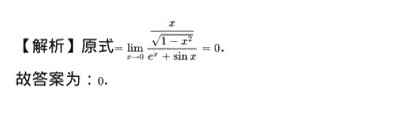题目
[题目] lim _(xarrow 0)dfrac (1-sqrt {1-{x)^2}}({e)^x-cos x}= __

题目解答
答案

解析
步骤 1:分子有理化
为了消除根号,我们对分子进行有理化处理。分子乘以它的共轭式,即 $\dfrac{1+\sqrt{1-x^2}}{1+\sqrt{1-x^2}}$,得到:
$$\lim _{x\rightarrow 0}\dfrac {(1-\sqrt {1-{x}^{2}})(1+\sqrt {1-{x}^{2}})}{(1+\sqrt {1-{x}^{2}})({e}^{x}-\cos x)}$$
步骤 2:化简分子
分子化简后得到:
$$\lim _{x\rightarrow 0}\dfrac {1-(1-{x}^{2})}{(1+\sqrt {1-{x}^{2}})({e}^{x}-\cos x)}$$
$$=\lim _{x\rightarrow 0}\dfrac {x^{2}}{(1+\sqrt {1-{x}^{2}})({e}^{x}-\cos x)}$$
步骤 3:应用洛必达法则
由于分子和分母在$x=0$时都为0,我们应用洛必达法则,对分子和分母分别求导:
$$\lim _{x\rightarrow 0}\dfrac {2x}{(1+\sqrt {1-{x}^{2}})'({e}^{x}-\cos x)+(1+\sqrt {1-{x}^{2}})({e}^{x}+\sin x)}$$
步骤 4:计算导数
分子的导数为$2x$,分母的导数为:
$$\dfrac {x}{\sqrt {1-{x}^{2}}}({e}^{x}-\cos x)+(1+\sqrt {1-{x}^{2}})({e}^{x}+\sin x)$$
步骤 5:代入$x=0$
将$x=0$代入上述表达式,得到:
$$\lim _{x\rightarrow 0}\dfrac {2x}{\dfrac {x}{\sqrt {1-{x}^{2}}}({e}^{x}-\cos x)+(1+\sqrt {1-{x}^{2}})({e}^{x}+\sin x)}$$
$$=\dfrac {0}{\dfrac {0}{\sqrt {1-0}}(1-1)+(1+\sqrt {1-0})(1+0)}$$
$$=\dfrac {0}{0+2}$$
$$=0$$
为了消除根号,我们对分子进行有理化处理。分子乘以它的共轭式,即 $\dfrac{1+\sqrt{1-x^2}}{1+\sqrt{1-x^2}}$,得到:
$$\lim _{x\rightarrow 0}\dfrac {(1-\sqrt {1-{x}^{2}})(1+\sqrt {1-{x}^{2}})}{(1+\sqrt {1-{x}^{2}})({e}^{x}-\cos x)}$$
步骤 2:化简分子
分子化简后得到:
$$\lim _{x\rightarrow 0}\dfrac {1-(1-{x}^{2})}{(1+\sqrt {1-{x}^{2}})({e}^{x}-\cos x)}$$
$$=\lim _{x\rightarrow 0}\dfrac {x^{2}}{(1+\sqrt {1-{x}^{2}})({e}^{x}-\cos x)}$$
步骤 3:应用洛必达法则
由于分子和分母在$x=0$时都为0,我们应用洛必达法则,对分子和分母分别求导:
$$\lim _{x\rightarrow 0}\dfrac {2x}{(1+\sqrt {1-{x}^{2}})'({e}^{x}-\cos x)+(1+\sqrt {1-{x}^{2}})({e}^{x}+\sin x)}$$
步骤 4:计算导数
分子的导数为$2x$,分母的导数为:
$$\dfrac {x}{\sqrt {1-{x}^{2}}}({e}^{x}-\cos x)+(1+\sqrt {1-{x}^{2}})({e}^{x}+\sin x)$$
步骤 5:代入$x=0$
将$x=0$代入上述表达式,得到:
$$\lim _{x\rightarrow 0}\dfrac {2x}{\dfrac {x}{\sqrt {1-{x}^{2}}}({e}^{x}-\cos x)+(1+\sqrt {1-{x}^{2}})({e}^{x}+\sin x)}$$
$$=\dfrac {0}{\dfrac {0}{\sqrt {1-0}}(1-1)+(1+\sqrt {1-0})(1+0)}$$
$$=\dfrac {0}{0+2}$$
$$=0$$